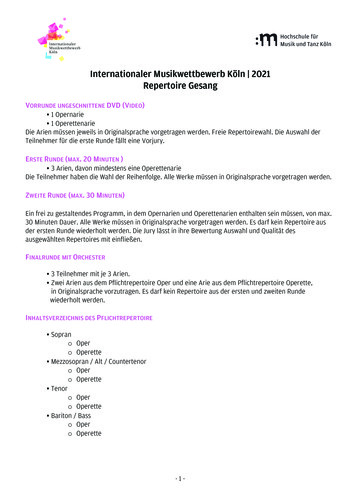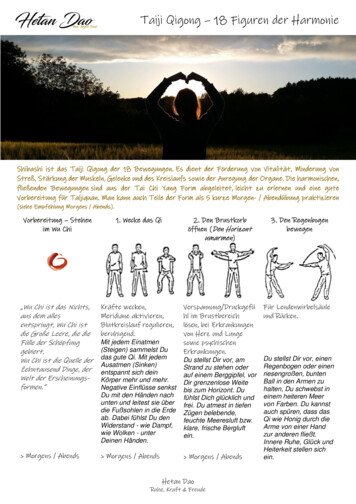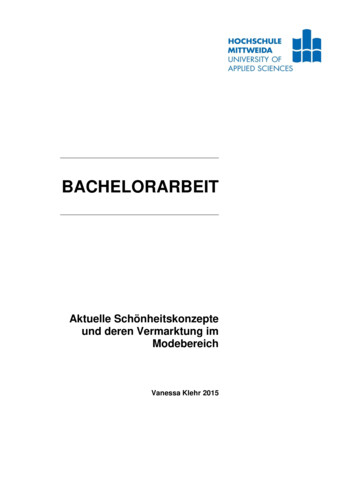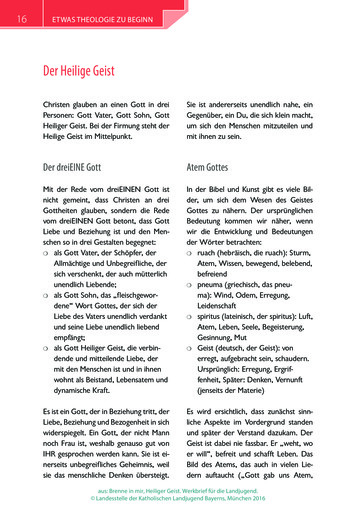
Transcription
Microgrids & DER Systems for HealthcareCSHE San DiegoJune 10, 2021Alberto Nebel – Service Sales EngineerLarry Rozcicha – Business Development ManagerNathan Justice – Application Engineer 2015 Eaton. All Rights Reserved.
Agenda Power concerns in CA Healthcare facilities Overview of a Microgrid DER- Distributed Energy Resources Feasibility Studies & Contractual mechanisms Live Microgrid Demo – Nathan Justice Questions 2015 Eaton. All Rights Reserved.2
Hospital Building Safety Board (HBSB) & Energy Conservation and Mgmt (ECM) – White Paperpresented to OSHPD as guide for the adoption of a Microgrid technology to reduce or eliminatethe need to rely on generators as the source of emergency powerWritten by Industry ExpertsJustin Carron – EATONSegment Director 2015 Eaton. All Rights Reserved.3
Power Issues facing CA Hospitals Public Safety Power Shutoff (PSPS) In 2019 248 Hospitals were in areas affected by PSPS Longer Power Disruptions in excess of stand by generation requirementsOutages due to Natural Disasters Extended outages may happen due to back up fuel accessibility issues / road closures Fire season is all year - 57,000 Wildfires from 2013 to 2019 – Avg 8,000/yr Earthquakes Weather – Super Storm Sandy, Hurricanes, Texas “freeze” Power Capacity stress due to extenuating circumstances – COVID Pandemic CA Senate Bill 100 (SB100) – Energy Provider Carbon Neutral by 2045 Cost gets passed on through rate increases Cybersecurity Attacks Power Disruptions due to Terrorism & social disturbances Aging Grid Infrastructure Rising costs of Energy Issues with DER integration into the grid may trigger Curtailment 2015 Eaton. All Rights Reserved.4
Megatrends Impacting today’s US power girdSolar / WindGrid instabilityEarthquakesCyber SecuritySystem OutagesRetiring PlantsDisastersStorm SurgeAging Grid2015 Eaton. All Rights Reserved.HurricanesStorm Surge5
What is a Microgrid?A microgrid is a self-sufficient energy system that servesa discrete geographic footprint, such as a hospital siteor building Local Independent – ability to “Island” Precise Control of DER sources by a Microgrid Controller Operate 24/7/365 managing and supplying energy to customers 2015 Eaton. All Rights Reserved.
Why Do You Want a Microgrid ? 2015 Eaton. All Rights Reserved.7
So . what does it look like 2015 Eaton. All Rights Reserved.8
Energy and Grid Transformation 2015 Eaton. All Rights Reserved.9
Key Components of a Microgrid DER User Interface Loads Historian Microgrid Control PCC Equipment Protection Supporting Electrical Infrastructure 2015 Eaton. All Rights Reserved.10
Microgrid control adds value and optimizes performance Manage PeakDemand / TOU Optimize Renewables Utilize Lowest-CostSources Minimize PF ctionsReduce Cost Demand Response Volt/Var Management Energy Arbitrage Frequency Regulation Renewable firming Disturbance RideThroughGenerateRevenueImprovePower ze Minimize Fuel Cost Minimize Emissions Maximize RenewablesIslandedStabilize PV Curtailment & Ramp Rate control Prioritize & Balance Sources, Loads 2015 Eaton. All Rights Reserved.11
Microgrid control manages state transitions for resiliencyPlanned IslandingDispatchFunctions Controlled / managed transition to minimize riskTransitionFunctionsGridConnectedUnplanned Islanding Speed / latency considerations Selection of DER equipment is key Stability analysis / load shedding is criticalIslanding(Planned/Unplanned)ReconnectBlack Start Intelligent source selection Load restorationIslandedReconnection to Grid Control DERs to synchronize voltage and current 2015 Eaton. All Rights Reserved.12
Code compliant Microgrid for Healthcare Facilities Current Code Compliance for normal power State & Local codes are adhered to System does not jeopardize the reliability of healthcare facilty Emergency Power separate from MicrogridCode issues for Microgrids as an EPS (Emergency Power Supply) NFPA 110, 99 & CEC codes written around generators & ATS Without reducing the reliability of the emergency system2021 NFPA 99 states:“Microgrids can be used as an EPS if designed with sufficientreliability to provide effective facility operation consistent with thefacility emergency operation plan” – no criteria to measure by toenforceCurrent code with interpolations can be used to show compliance for designsthat utilize microgrids as EPS.NEW CODE REVISIONS underway – white paper 2015 Eaton. All Rights Reserved.
Power System Challenges for Hospitals Stranded Assets vs Always On Assets Diesel Generators can become Stranded Assets and may fail when needed Possible limited run time capabilities due to fuel accessAlways on Assets participate in daily energy supply DER - Cogen CHP, Solar, fuel cells, battery storage Fuel Access Restrictions NFPA-110 – Hospitals classified as Critical Facilities Requires 96 hours of fuel storage for Emergency Power Assumes that outage will be remedied within that time frame or extra fuel can be accessed Air Quality in short duration outages 2015 Eaton. All Rights Reserved.14
DER – Distributed Energy ResourcesMicrogrid system gives hospitals an intelligent, transparent way to manage their thealways-on energy assets, also known as Distributed Energy Resources (DERs) in amanner that idle generators cannot match 2015 Eaton. All Rights Reserved.15
DER – “Always On” System AdvantagesIn California, utilities charge based on both electricity use (kWh) and demand(kW). A microgrid system can be used to dynamically manage loads to reducepeak demand, or “ratchet,” charges by consuming more energy from onsitesources or temporarily turning off non-critical loads Avoid Peak Demand PentaltiesIn California, utilities charge based on both electricity use (kWh) and demand (kW). A microgridsystem can be used to dynamically manage loads to reduce peak demand, or “ratchet,” chargesby consuming more energy from onsite sources or temporarily turning off non-critical loads Tariff ManagementBy taking advantage of time-of-use (TOU) rates implemented by California utilities, healthcarefacilities can determine when it makes economic sense to consume each energy resource,shifting some loads to “off peak” periods and storing energy for use at a later time. Demand Response ParticipationWith the ability to generate energy onsite, healthcare facilities can curtail load pulled from thecentral grid in return for financial reimbursement. 2015 Eaton. All Rights Reserved.16
DER – “Always On” System AdvantagesHBM may be also be used to reduce energy costs during day-to-day operations due to theability to manage external power delivery to/from the main grid when energy resources areconfigured to be “always-on” and loads are differentiated in essential and non-essential(switchable) loads. Time of Use Energy Cost Peak Demand TariffsTime of use (ToU) refers to the price of electric energy (typically measured in kWh) as a function of the time of day in a week and is seasonally adjustedPeak demand is the measured maximum power peak during a monthly billing cycle 2015 Eaton. All Rights Reserved.17
Battery Energy Storage System LIB best suited for healthcare campus settings due to high energydensity Cost declines 40-60% in next 30 years – 85% reduction since 2010BESS Applications Peak Demand Reduction – Peak period typically 4 hours Renewable Energy Firming – “Smooth out” the intermittentfluctuations of solar productions – prevents energy curtailment Spinning Reserve – Gas gens optimized efficiency at 40%, if gensets are staged BESS can serve additional load before nextgenerator is activated, thereby gens are kept at optimal efficiencyBESS can’t replace back up generator – 4 hours LIB vs 72-96 hrs Gen Only short term or priority loads Solar Battery can’t provide back up power for an entire facility – limitsin space and discharge duration Fire hazard 2015 Eaton. All Rights Reserved.
Solar - Photovoltaic Clean intermittent Energy Cost trending down – 10X since 2007 Three configurations Carport Ground Mount RooftopChallenges: Power Density – requires 3X the space than traditional energy sources PV Curtailment – no export of energy benefits (need storage) 2015 Eaton. All Rights Reserved.
Fuel Cell Energy Non-combustion technology - NASA Reduces greenhouse emission & zero pollutants (natural gas, biogas & hydrogen) Produces water & heatModular stacked design to create power Modules generating DC power Redundant & independent ensures max uptime Scalable for power needsNormal Source – Allows to act as a 24/7 always on back up system toGreat for Remote locations 2015 Eaton. All Rights Reserved.20
Wind Energy 5,535 MW of Capacity operating in CA Today 7.2% of all power generated in CA in 2018 Costs for wind have declined 27% from 2013 to 1018 Technology has improved efficiency and outputChallenges for Wind in Microgrid installations for CA Hospitals Intermittency of Supply not suitable for Critical Infrastructure Wind Speed (4m/s) not feasible in most areas of the state Limits on Turbine location due to noise & safety concerns Rooftop mount discouraged due to vibration transmission and structural concerns Visual and aesthetic concerns 2015 Eaton. All Rights Reserved.
CoGeneration – Combined Heat & Power Lower Costs Reduce Greenhouse gas emissions Provide reliable source of self generatedpowerCogeneration increasesefficiency of a stand-alonenatural gas engine-generatorsets from 40% to close to 90% 2015 Eaton. All Rights Reserved. Cogen Equipmentcaptures exhaust heatto be used in facilityprocesses such asspace heat Steam, hot water, orexhaust combinedwith absorptionchillers to producecold water & cool air
The microgrid energy system conceptUtilityWindDistributed Energy Sources Backup Generation In-House Co-Gen CHP (Combined Heat and Power) On-Site Renewables and Fuel Cells Energy Storage (Batteries)Back-up GenerationBatterySolarLocal “Grid Within a Grid” Delivers Power Resilience,Reliability and UptimeFacilityCritical LoadsIn-House Co-GenImagery 2015 Google, Map data 2015 GoogleA group of generating assets and defined loads thatcan operate within the utility grid or islanded from the grid,as a self-sufficient stand alone application 2015 Eaton. All Rights Reserved.Microgrid Applications Islanding & Synchronization Black Start Generation/Load Balance Control Battery Energy Storage & FrequencyRegulationRequires Control System “Glue”to Achieve System Performance23
Microgrid & Distributed Generation Acronyms DERDistributed Energy Resource(Wind, Solar, Hydro, Any On-site Generation or Controllable Load) DERMS POCDER Management SystemPoint Of Connection PCCPoint of Common Coupling POIPoint Of Interconnect BESSBattery Energy Storage System PCSPower Conversion System BTMBehind-The-Meter FTM ISOIndependent System Operator TOUTime of Use (utility rate structure) CHPCombined Heat & Power PXeOEaton’s Power Xpert Energy Optimizer controller VMGVirtual Microgrid (system modelling) HILHardware-In-Loop (system model) PILProtection-In-Loop or Power-in-Loop (systemmodel) ROIReturn On Investment IRRInvestment Rate of ReturnFront Of The Meter 2015 Eaton. All Rights Reserved.24
2015 Eaton. All Rights Reserved.25
Virtual Microgrid CapabilitiesDistribution model portable fromCYME Generic and customizable DERmodels Easy communication configurationwith most popular protocols (Modbus,IEC61850, DNP3, ect.) Easy profile integration for casestudies Capable of integratingLVRT/HVRT/ZVRT with protectioncoordinationMicrogrid ControllersSystem ControllerManaged Network SwitchLocal Controller– GENLocal Controller– ESSFlexible in terms of model fidelity Use as digital twin for microgridcontroller(s) development andvalidationLocal Controller– PVManaged Network SwitchGen Comm IntfESS Comm IntfPV Comm IntfRelay Comm IntfGSE Comm IntfModel: easYgen3000Comm Type: ModbusIP Adr: 192.168.1.10Prefix: GENReg Map: .Model: Generic MESAComm Type: ModbusIP Adr: 192.168.1.11Prefix: ESSReg Map: .Model: Generic SunspecComm Type: ModbusIP Adr: 192.168.1.12Prefix: PVReg Map: .Model: SEL751Comm Type: IEC61850IP Adr: 192.168.1.13Prefix: RlyICD FileIED Name: SMPIOComm Type: GOOSEIP Adr: 192.168.1.14Prefix: GSEMessages: Communication SimulatorSimulated DMS Microgrid ServerCore 1 –Feeder ModelCore 2 –Genset ModelCore 3 –ESS ModelCore 4 –SolarPV ModelClockSyncData SetSimulation Set - PCC Meter P- PCC RlyTrip- GEN IsochEn- PV Meter PF- ESS Vset- .Simulation ProfileMicrogrid Model in PSCADVirtual Microgrid 2015 Eaton. All Rights Reserved.26
3. Understand financing options – How is the project beingfunded?1. Opportunity Discovery / Identification Rationale/Reason for the need (i.e. Peak shaving, PowerQuality, Load Sharing, Utility Interruptions/issues, EnergyManagement/Efficiency strategy, etc.) Define Energy Management Strategy & Goals Understand Total Power and / or Anticipated Power Needed(KW, MW, etc.) Direct or through financial offsets (PPA, ECIP, ESPC) orownership transfer (UESC, EUL)4. Connect with local/current utility or power provider - preferablyin conjunction with power consumer5. Define Scope of SupplyUnderstand Loads - Critical and Total6. Define need for partners, supplier(s) of non-Eaton scope2. Identify "owner/operator" of the new microgrid system Developer End User Utility7. Collaborate & Strategize with partners 2015 Eaton. All Rights Reserved.Engage partners and assign interface/coordination lead fromEaton27
Microgrid Operations and MaintenanceHealthcare facilities should clearly define the party responsible forongoing microgrid operations and maintenance (O&M),1. Do-It-Yourself.1. Least Expensive2. Steep Learning Curve3. Employee Turnover & Training2. Third-Party Contractor1. Specialize in microgrid O&M Services2. Can be economical through RFP process3. Microgrid Integrator1. Familiarity with system quick resolution2. Can be included in project costs 2015 Eaton. All Rights Reserved.
Microgrid EssentialsNECESSITIES TO MOVE FORWARD: Technical Feasibility Economic Viability Facility / Loads / Stakeholder Buy-in and Agreements Utility Cooperation Assured System Reliability Regulatory Approval Environmental Permits Financing Options Financial Return Societal Benefit Cost Ratio 1 Takes Advantage of Federal & State Incentives 2015 Eaton. All Rights Reserved.29
State Incentives for Renewables & EfficiencyHyperlink -http://www.dsireusa.org/ 2015 Eaton. All Rights Reserved.30
Microgrid Benefits Avoid utility demand penalties. Dynamically manage loads to reduce peak demand Tariff Management. taking advantage of time-of-use (TOU) rates implemented by California utilities, healthcare facilitiescan determine when it makes economic sense to consume each energy resource, shifting some loads to“off peak” periods and storing energy for use at a later time. Demand Response Participation. With the ability to generate energy onsite, healthcare facilities can curtail load pulledfrom the central grid in return for financial reimbursement. Local power generation. A microgrid creates energy for the building or site that it serves as opposed to requiring powerFrom a centralized utility that may lose 8-15% is dissipation due to distances that the energy may have to travel to reach it’sintended location. Independence. A microgrid can disconnect from the utility and island when utility power is unavailable or interrupted. one ofthe most important distinctions of an HBM is the functional resiliencythe HBM provides: the possibility of fail-safe islanding of a hospital’s life safety emergency power branchand providing reliable power backup services during grid outages 2015 Eaton. All Rights Reserved.31
Grid ServicesA resilient HBM that decides to improve its resiliency by providing always-on DERs opens the possibility to participate ingrid services that provide cost savings for the microgrid operator by reducing electricity costs. It is also able to participate infinancial incentives that help in the stability of the grid. Such grid services may include: Voltage and Frequency Services. During the utility-connected mode of operation, a microgrid ownercan utilize DERs to opt into paid service by the utility companies. Utility Demand Management. A demand charge may be present that can be avoided by deftmanagement of a battery storage resource should it be part of the microgrid resources. Theresult would be reducing the utility costs. Time of Use Load Management. During the utility-connected mode of operation,a microgrid owner can utilize the always-on distributed energy resources (DERs) in the grid to opt intopaid service by the utility companies. 2015 Eaton. All Rights Reserved.32
PSEC MICROGRID DEMO 2015 Eaton. All Rights Reserved.33
PSEC Working Microgrid 2015 Eaton. All Rights Reserved.34
PSEC Working MicrogridSourcesUtility SourceEaton Network Utility 100 kW Generator 28 kW Photovoltaic 30 kW Battery Storage (30kWh)ServerEDR 5000ProtectionRelayUtility Connection /Islanding ContactorPower XpertEnergy Optimizersystem controllerPowerPlex IITransducerLoads 4 Controllable HVAC units(4 -25 kW) Lights, outlets, etc. (8-12kW)ControllableLoads(4 total)Generator BreakerPower XpertEnergy Optimizerlocal controllersBatteryUse Cases (partiallist)inverterSolarinvertersNatural GasGeneratorHVACPV ArraysBatteryEnergyStorage 2015 Eaton. All Rights Reserved.Building Loads Peak Power Limiting / LoadLeveling Demand Management Renewable Firming PV Shifting Power Factor Control Resiliency: Islandedoperation optimizingrenewables35
2015 Eaton. All Rights Reserved.
ExcessSolarexportedto UtilityBatteryinitiallyOffUtility PowerLimited to0-15 kWBatteryOnBatteryApproachingMaximumSOCBattery atDesiredSOC 2015 Eaton. All Rights Reserved.
In this example the solarand battery support theLoad 100% extra solarCapacity charges batteryThen is sold back to grid when batter is fully chargedUtility PowerLimited to0-7 kWExcess PVstored inbatteryUtility PowerExportlimited to 5kWBatteryApproachingMaximumSOCUtility PowerLimited to0-7 kWUtility PowerLimit raised to 13kW; desiredSOC 80%Battery atDesiredSOC(35%) 2015 Eaton. All Rights Reserved.Battery atDesiredSOC(80%)
In this example power fromUtility is kept at 10KWBattery and solar make upDifference to support loadUtility PowerLimit 12 kW(07:00 –20:00)BatterysupplementsSolarSolar chargesBatteryUtility PowerLimit 20 kW(20:00 – 7:00)Utility chargesBattery 2015 Eaton. All Rights Reserved.
EatonElectrical Engineering Services & SystemsField Services24/7 EmergencyResponseAcceptanceTestingPower SystemEngineeringStudies: Arc Flash MicrogridStartup Short CircuitCommissioning OvercurrentMaintenance HarmonicServiceContracts Load Flow Motor StartingPower SystemAutomationProtection &Control ngineer,Procure &Construct (EPC)Foreseer/EPMSPower XpertEnterpriseSolutionsLocal Support,Crisis ResponseMeteringBattery StorageMicroGridsTotal LifeCycle Solutions by Eaton 2015 Eaton. All Rights Reserved.Aftermarket &Life ExtensionMV & LV PowerCircuit BreakerReplacementEquipmentRebuild &ReconditioningLife Extension& Modernization40
Thank you, QuestionsAlberto Nebel – Senior Service Sales Engineeralbertonebel@eaton.com 619-646-0059Larry Rozcicha – Business Development Managerlarryrozcicha@eaton.com 503-807-5050Nathan Justice – Application Engineer – Energy Transitionnathanjustice@eaton.com 858-900-1649Senior Microgrid Application icrogrid 2015 Eaton. All Rights Reserved.41
with most popular protocols (Modbus, IEC61850, DNP3, ect.) Easy profile integration for case studies Capable of integrating LVRT/HVRT/ZVRT with protection coordination Flexible in terms of model fidelity Use as digital twin for microgrid controller(s) development and validation Communication Simulator et Core 1 t Feeder Model .











